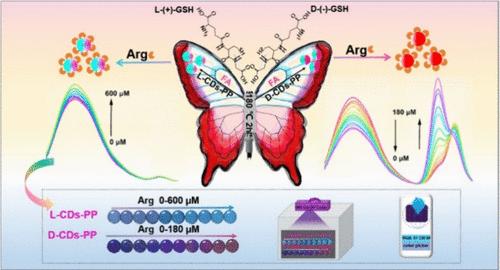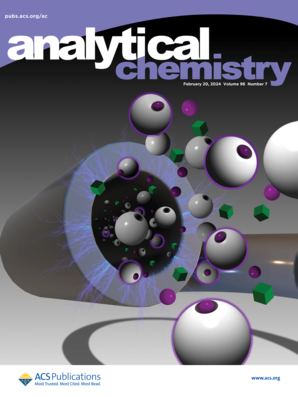Dual Ratiometric Fluorescence Sensors Based on Chiral Carbon Dots for the Sensitive and Specific Detection of Arginine
IF 6.7
1区 化学
Q1 CHEMISTRY, ANALYTICAL
引用次数: 0
Abstract
Arginine (Arg) is involved in tissue metabolism and regulates the immune function; thereby, achieving the detection of Arg is crucial for early diagnosis and treatment of diseases. Herein, dual ratiometric fluorescence sensors were prepared with the blue emission of levorotatory/dextrorotatory carbon dots (CDs) and the red emission of porphyrin (L/D-CDs-PP) for the sensitive and portable detection of Arg. Interestingly, L-CDs-PP and D-CDs-PP displayed not only the dual emission peaks at 493 and 650 nm but also different response modes to Arg; thus, they could serve as dual ratiometric fluorescence sensors to achieve the accurate and reliable detection of Arg, with the detection limit of 23.87 μM for L-CDs-PP and 2.39 μM for D-CDs-PP. Importantly, the solid-state sensors successfully achieved dual-mode visual and portable detection of Arg with the support of a smartphone platform. In addition, L-CDs-PP and D-CDs-PP exhibited excellent biocompatibility and cell imaging capabilities, and they could achieve the detection of Arg in cells and biological samples of urine and rat plasma. Therefore, the dual ratiometric fluorescence sensors exhibited broad application prospects in the fields of analytical sensing, biological imaging, and medical diagnosis.

基于手性碳点的双比例荧光传感器用于精氨酸的灵敏和特异检测
精氨酸(Arg)参与组织代谢,调节免疫功能;因此,实现精氨酸的检测对于疾病的早期诊断和治疗至关重要。本文采用左旋/右旋碳点(CDs)的蓝色发射和卟啉(L/D-CDs-PP)的红色发射制备了双比例荧光传感器,用于灵敏、便携地检测精氨酸。有趣的是,L-CDs-PP和D-CDs-PP不仅在493和650 nm处表现出双发射峰,而且对Arg的响应模式也不同;因此,它们可以作为双比例荧光传感器,实现对Arg的准确可靠检测,L-CDs-PP的检出限为23.87 μM, D-CDs-PP的检出限为2.39 μM。重要的是,该固态传感器在智能手机平台的支持下成功实现了Arg的双模视觉和便携式检测。此外,L-CDs-PP和D-CDs-PP具有良好的生物相容性和细胞成像能力,可实现细胞和尿液、大鼠血浆生物样品中精氨酸的检测。因此,双比例荧光传感器在分析传感、生物成像、医学诊断等领域具有广阔的应用前景。
本文章由计算机程序翻译,如有差异,请以英文原文为准。
求助全文
约1分钟内获得全文
求助全文
来源期刊

Analytical Chemistry
化学-分析化学
CiteScore
12.10
自引率
12.20%
发文量
1949
审稿时长
1.4 months
期刊介绍:
Analytical Chemistry, a peer-reviewed research journal, focuses on disseminating new and original knowledge across all branches of analytical chemistry. Fundamental articles may explore general principles of chemical measurement science and need not directly address existing or potential analytical methodology. They can be entirely theoretical or report experimental results. Contributions may cover various phases of analytical operations, including sampling, bioanalysis, electrochemistry, mass spectrometry, microscale and nanoscale systems, environmental analysis, separations, spectroscopy, chemical reactions and selectivity, instrumentation, imaging, surface analysis, and data processing. Papers discussing known analytical methods should present a significant, original application of the method, a notable improvement, or results on an important analyte.
 求助内容:
求助内容: 应助结果提醒方式:
应助结果提醒方式:


